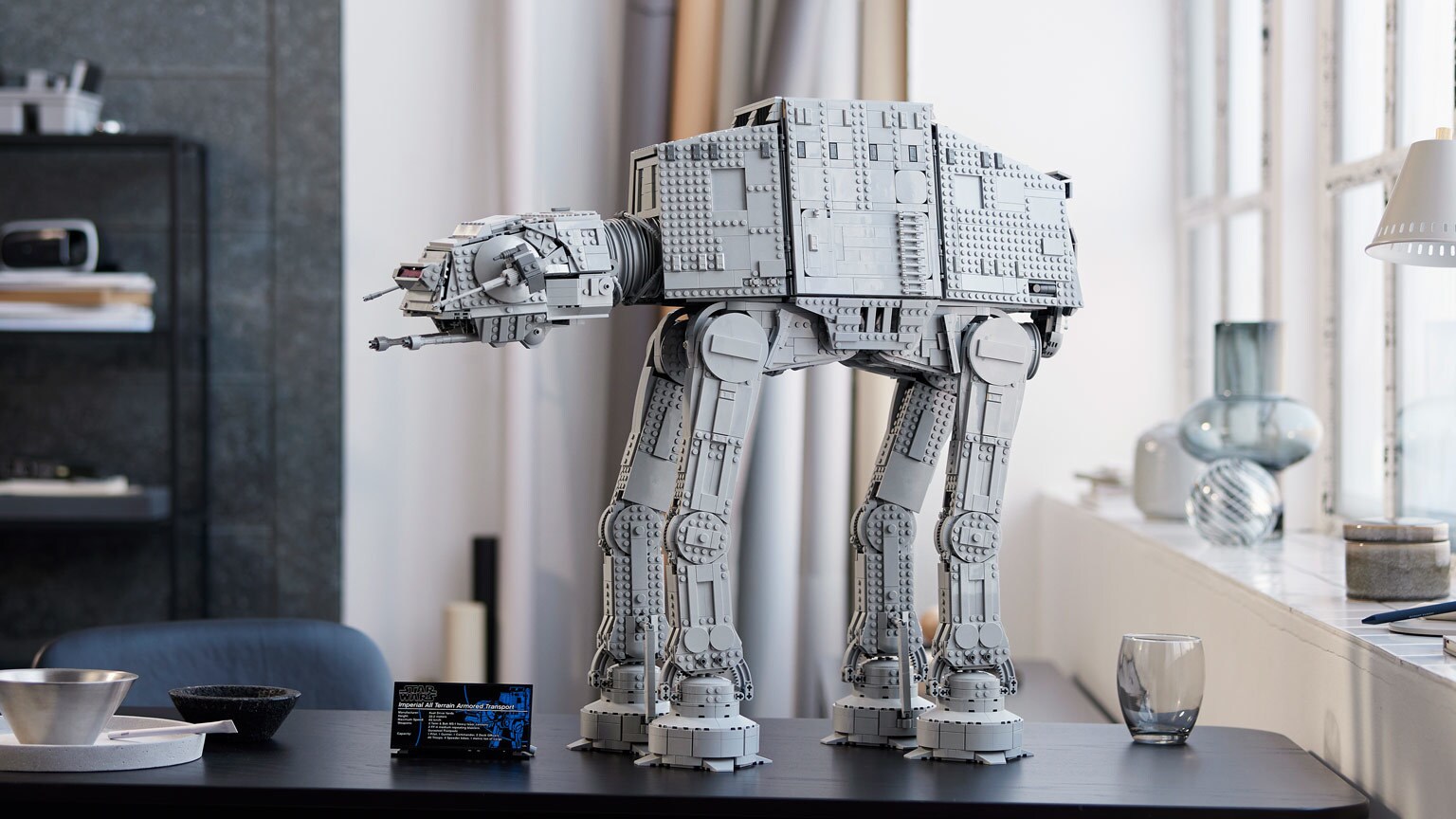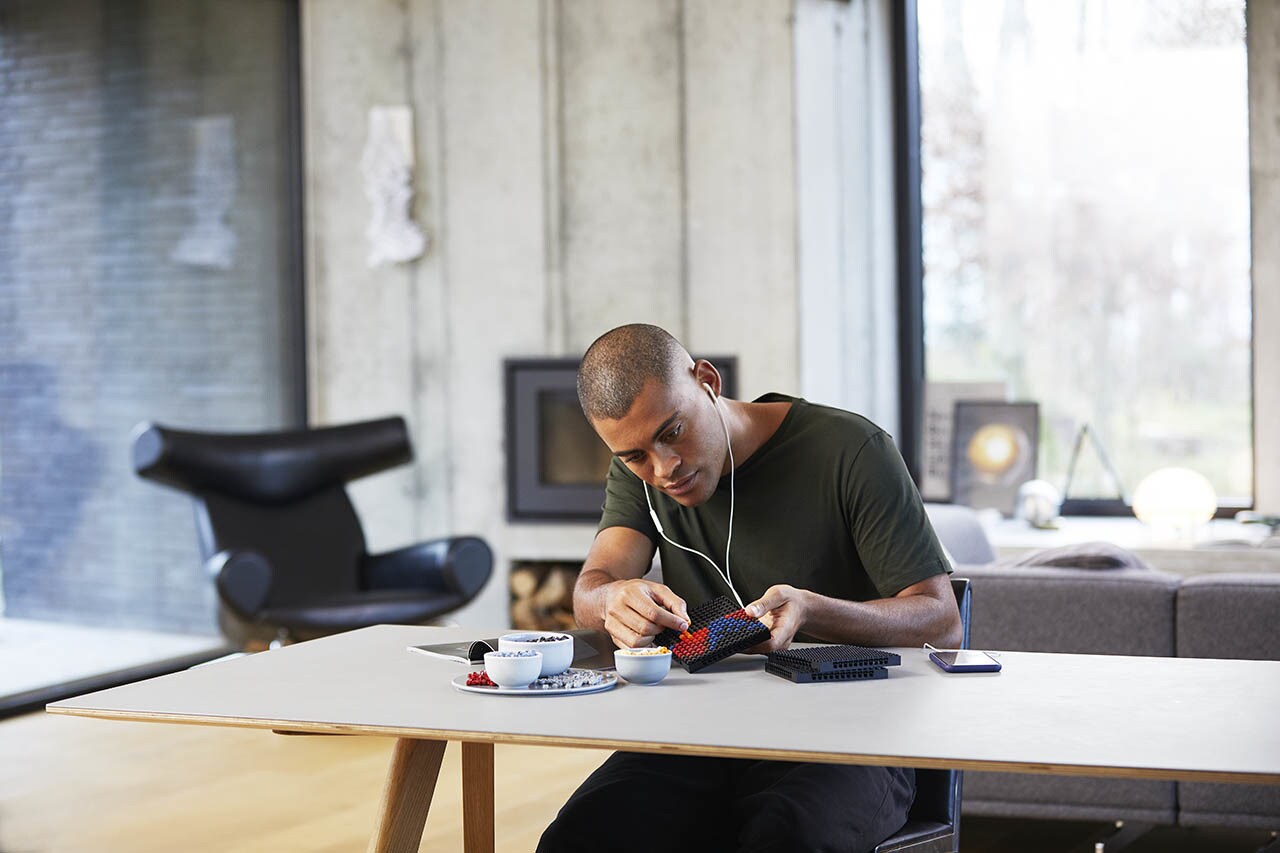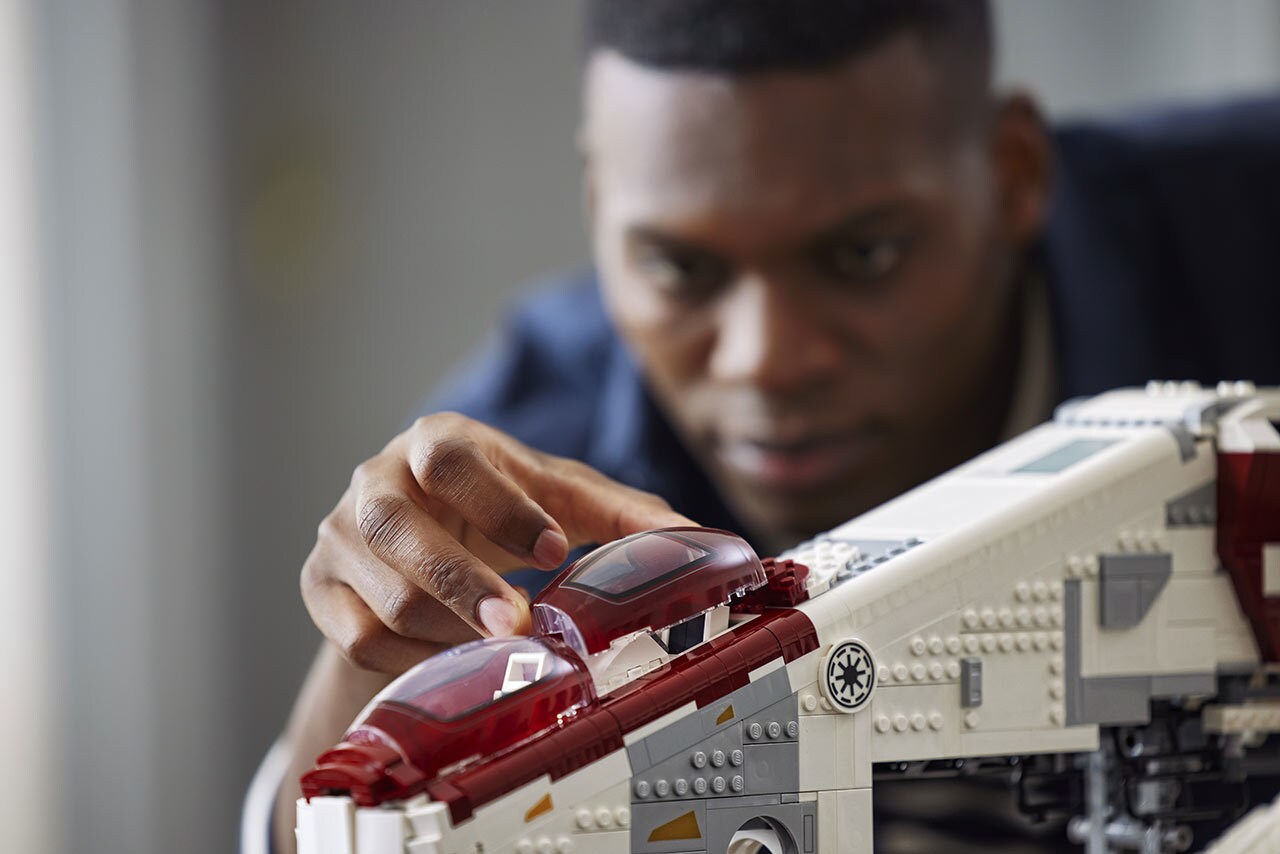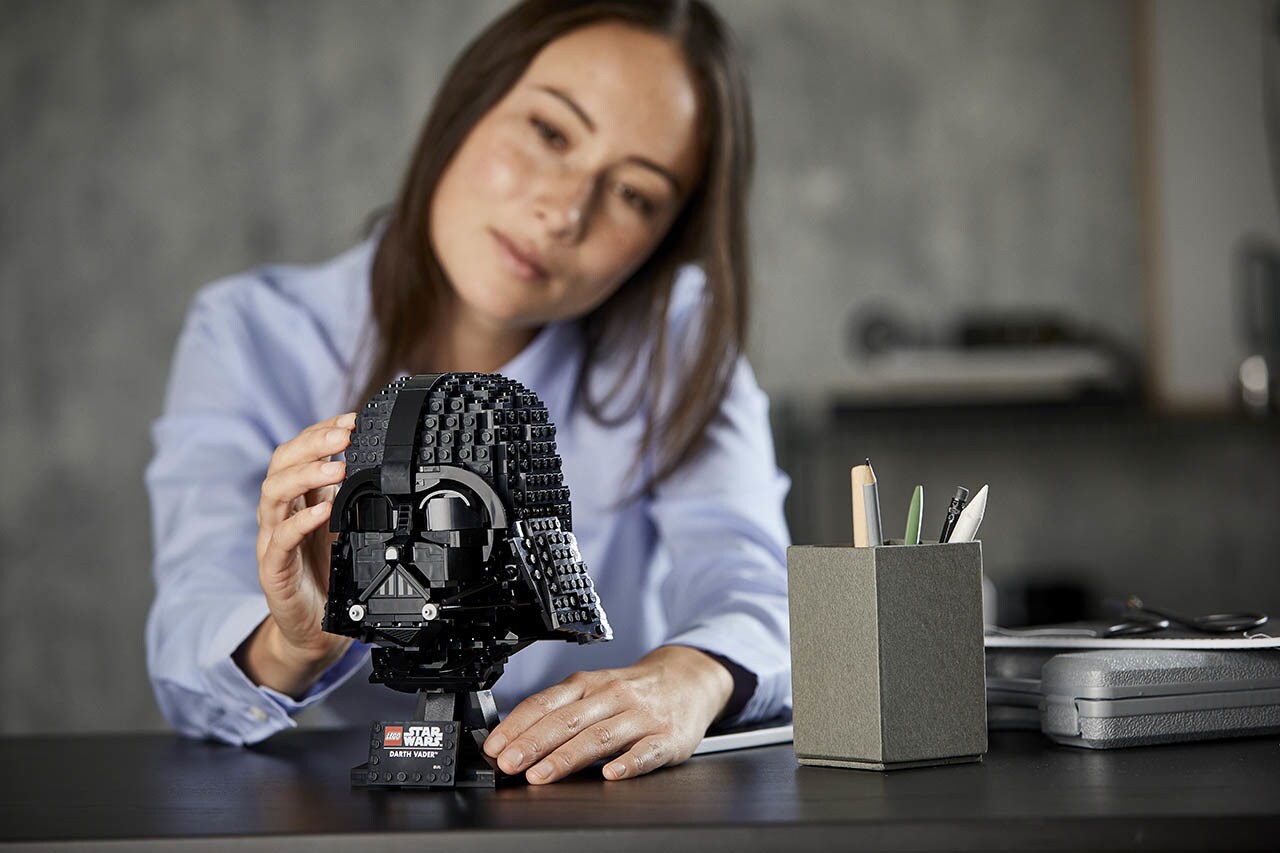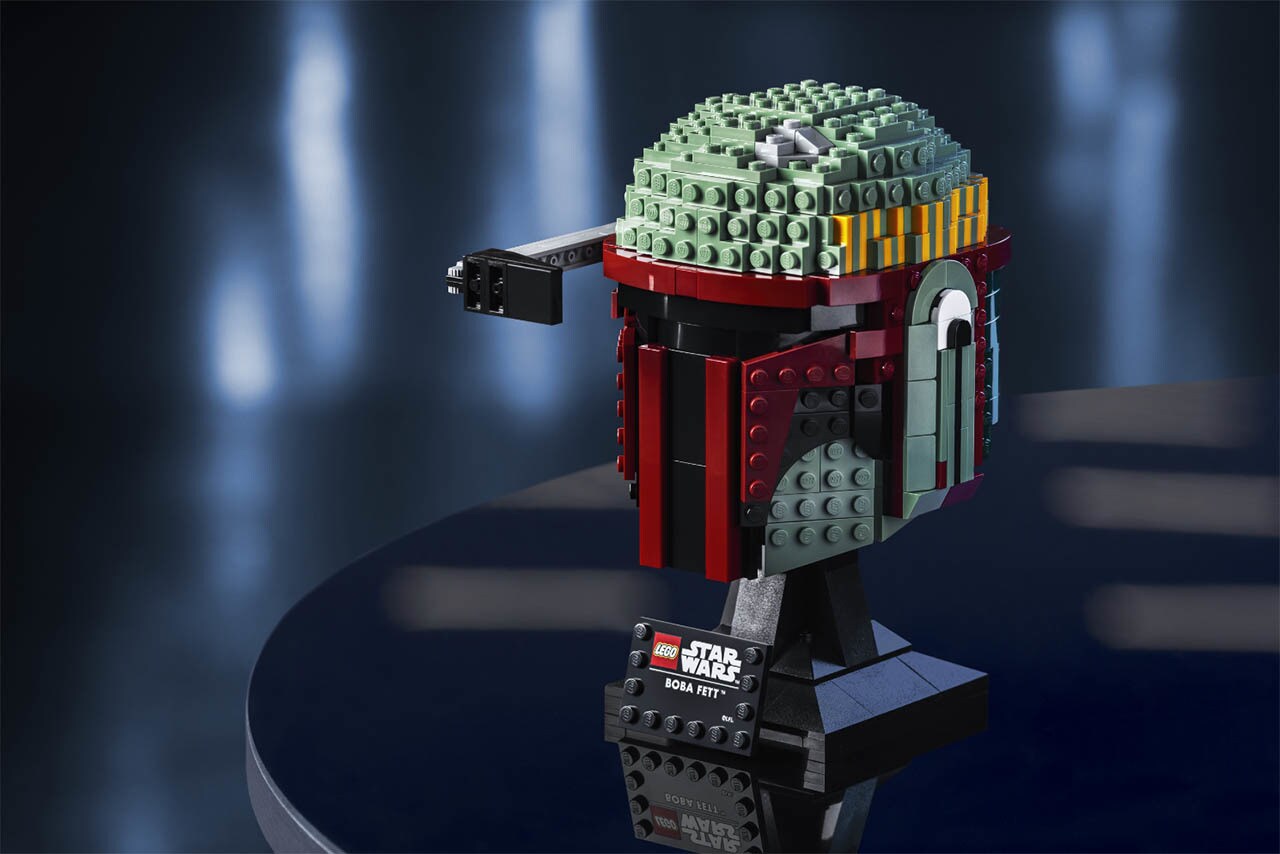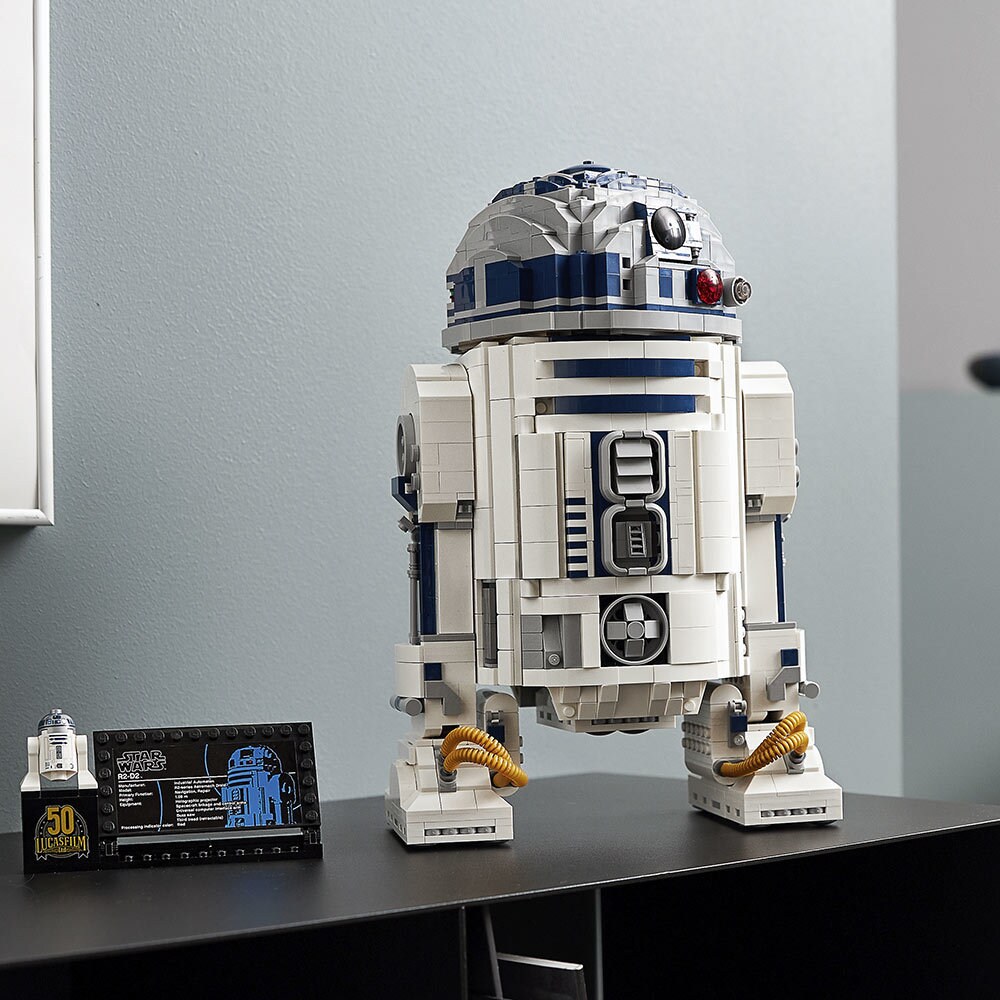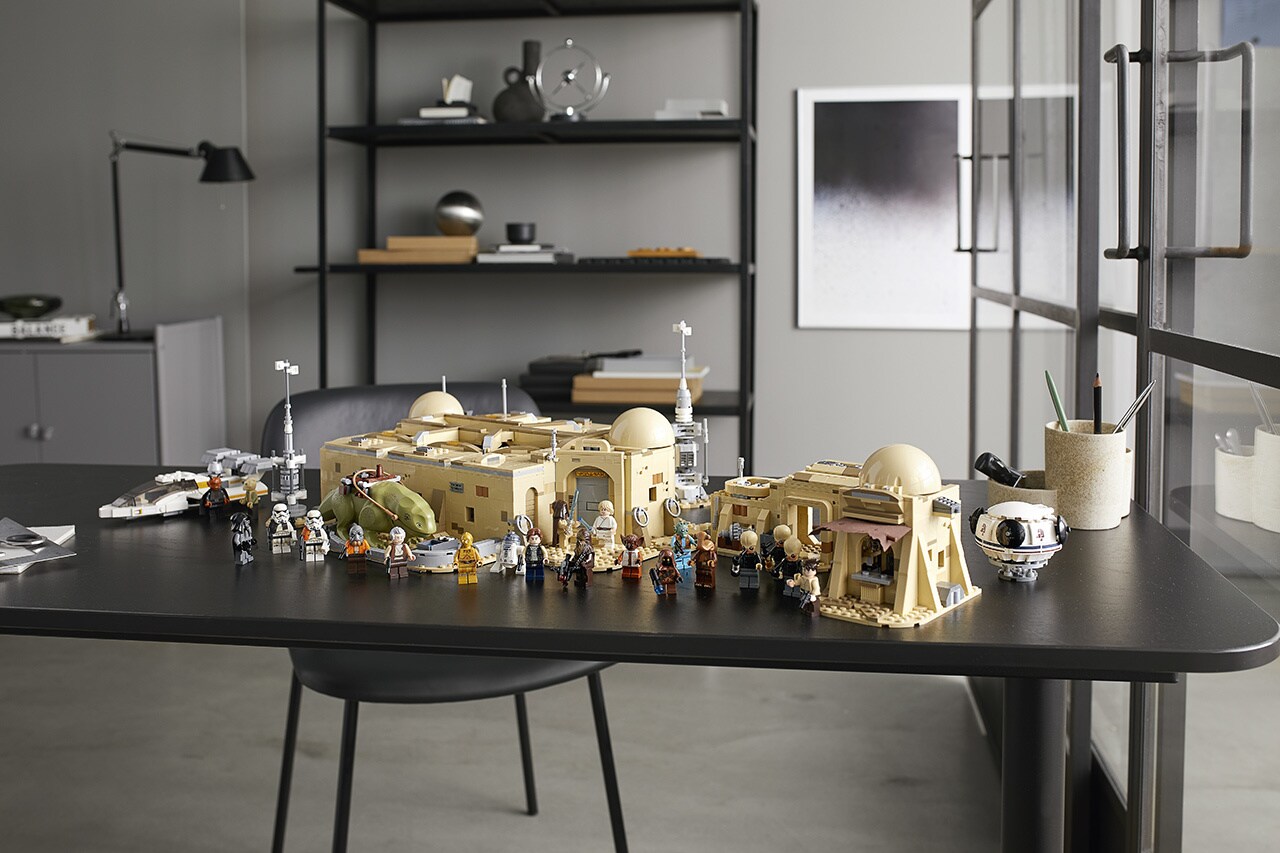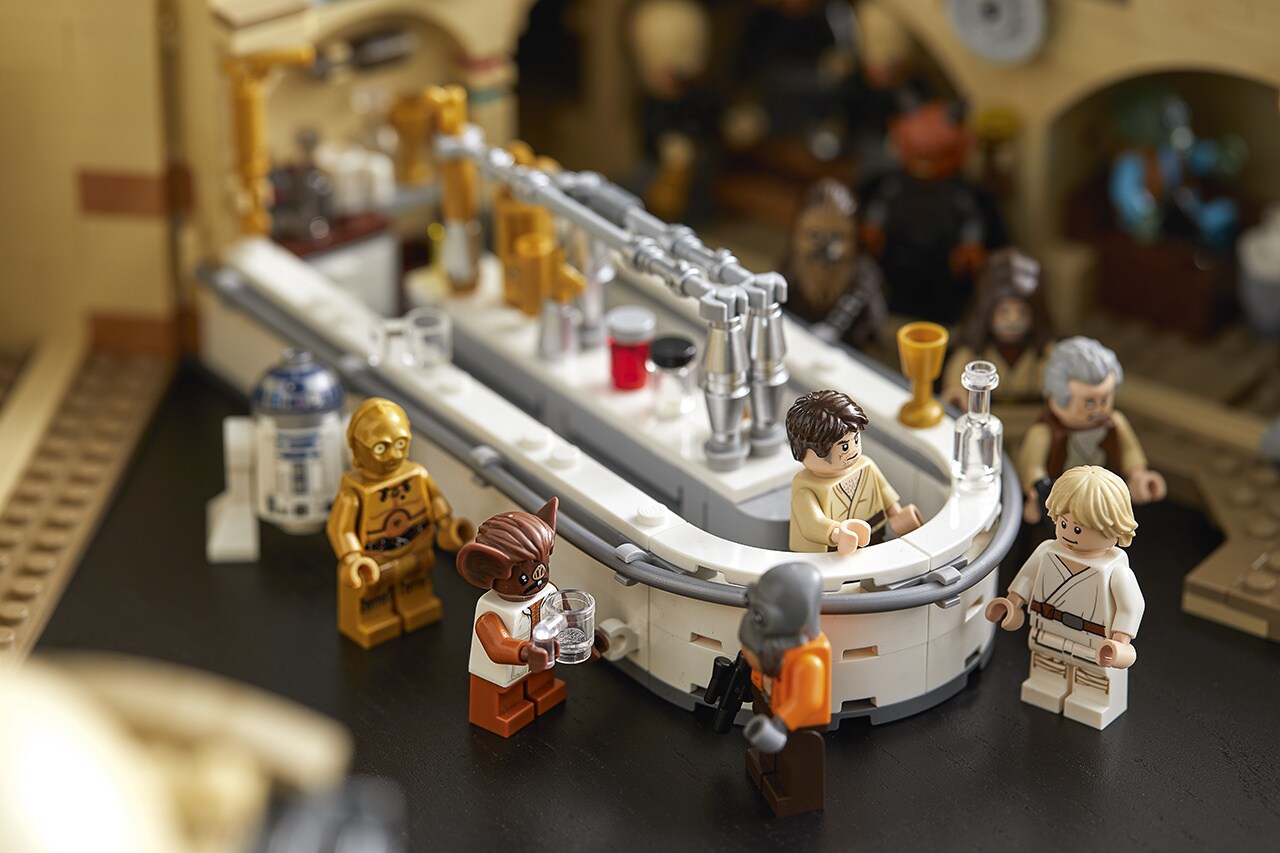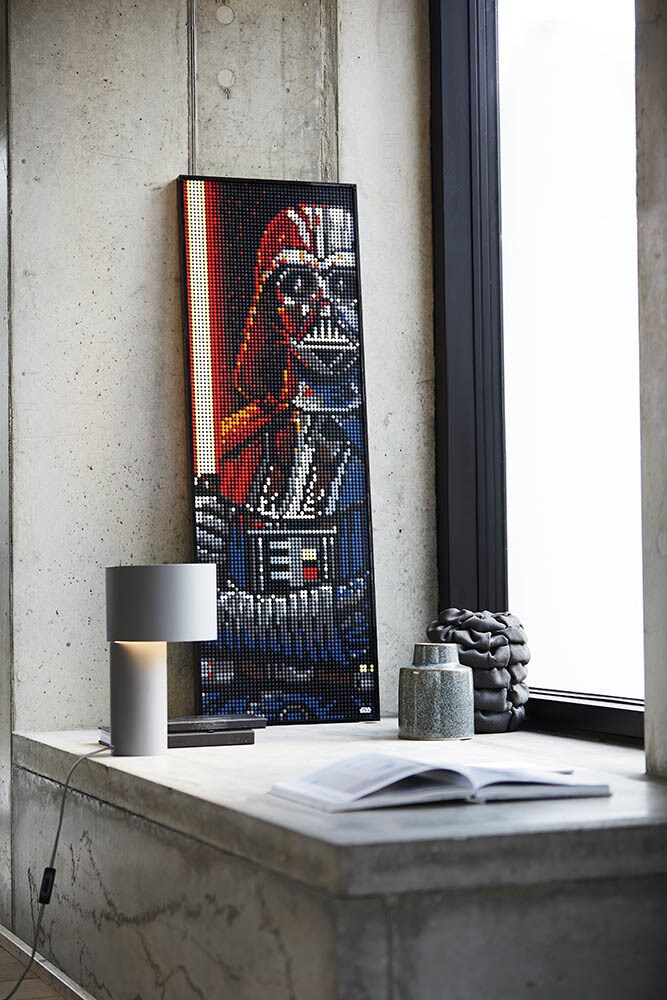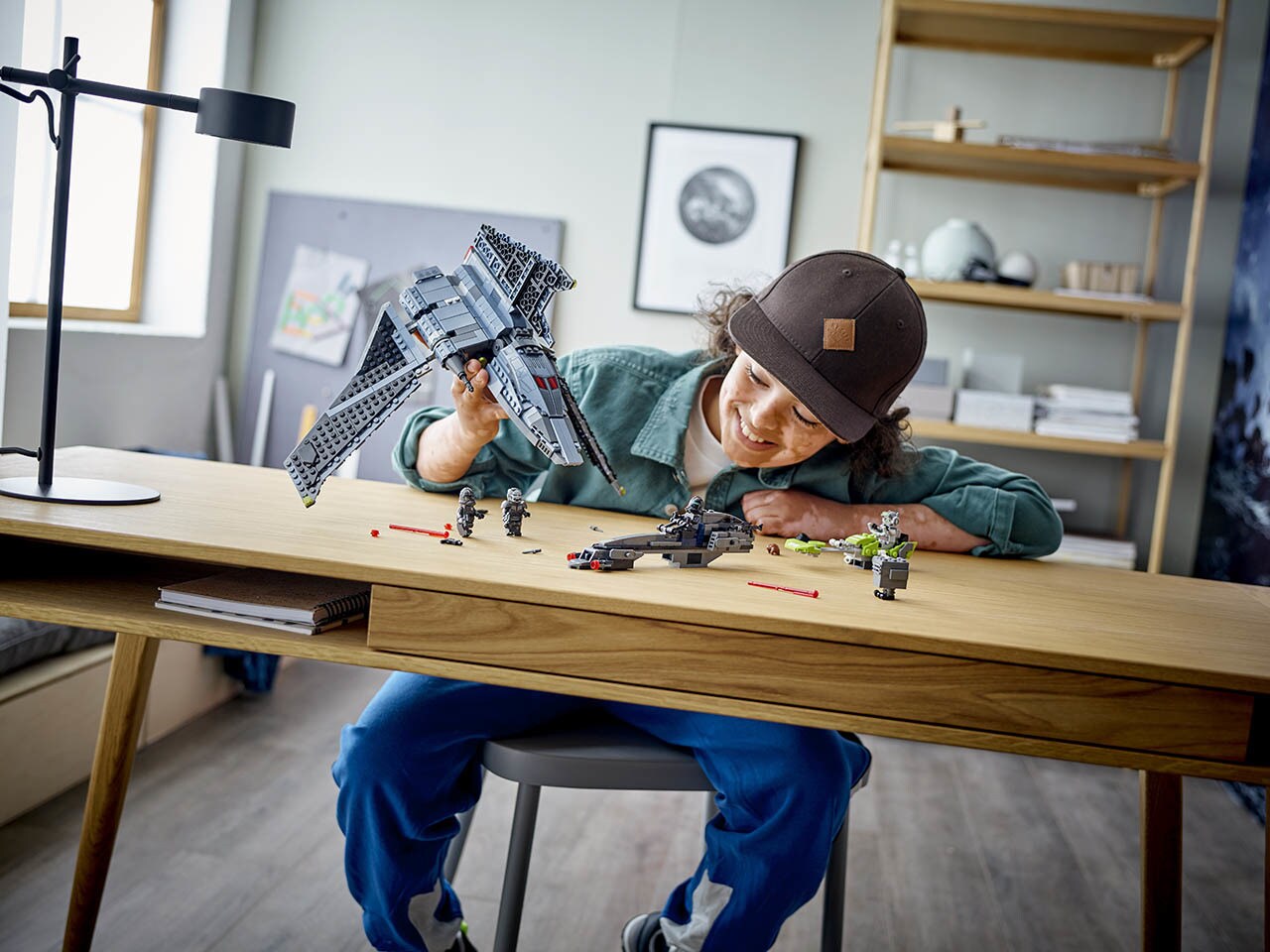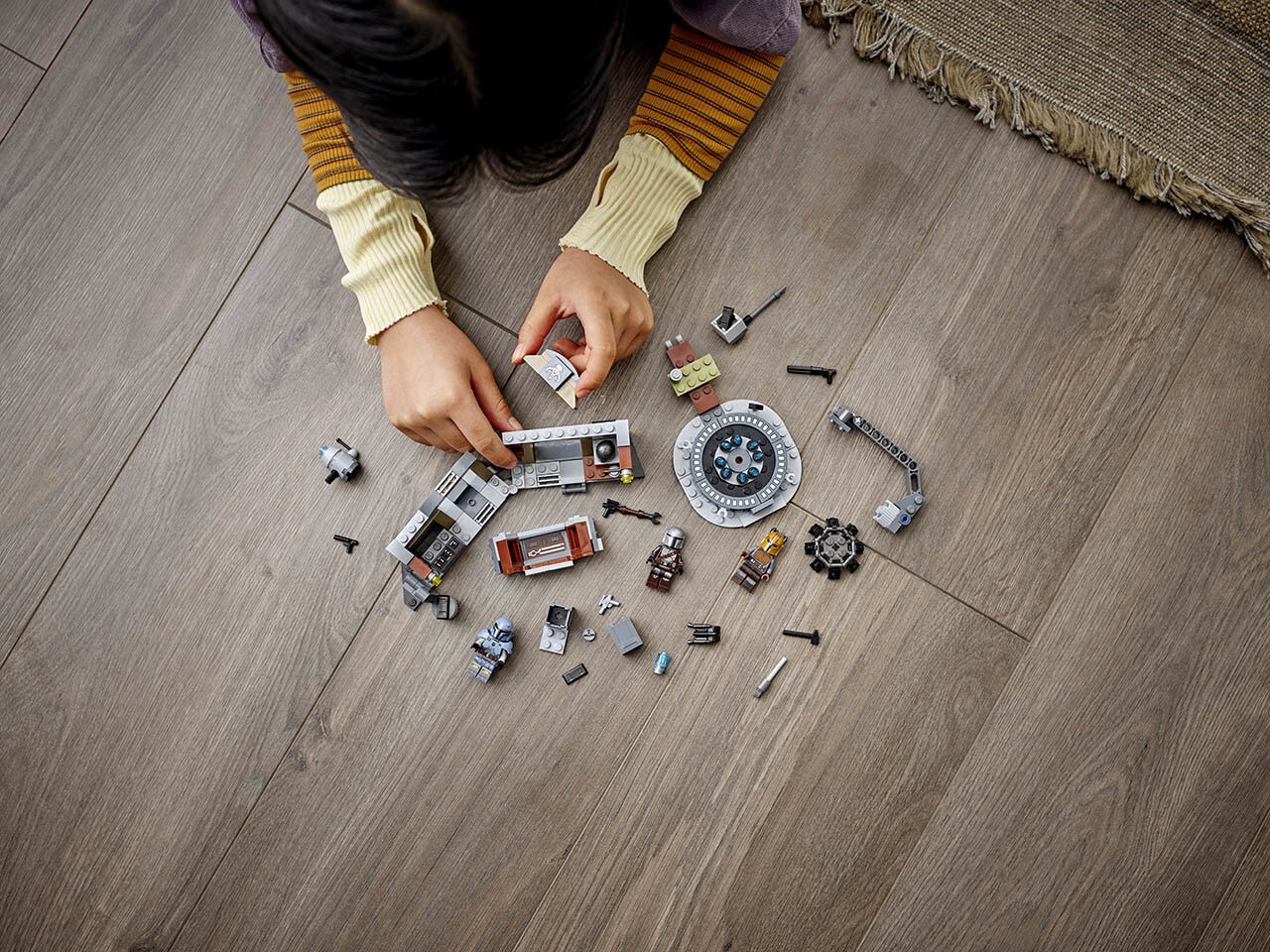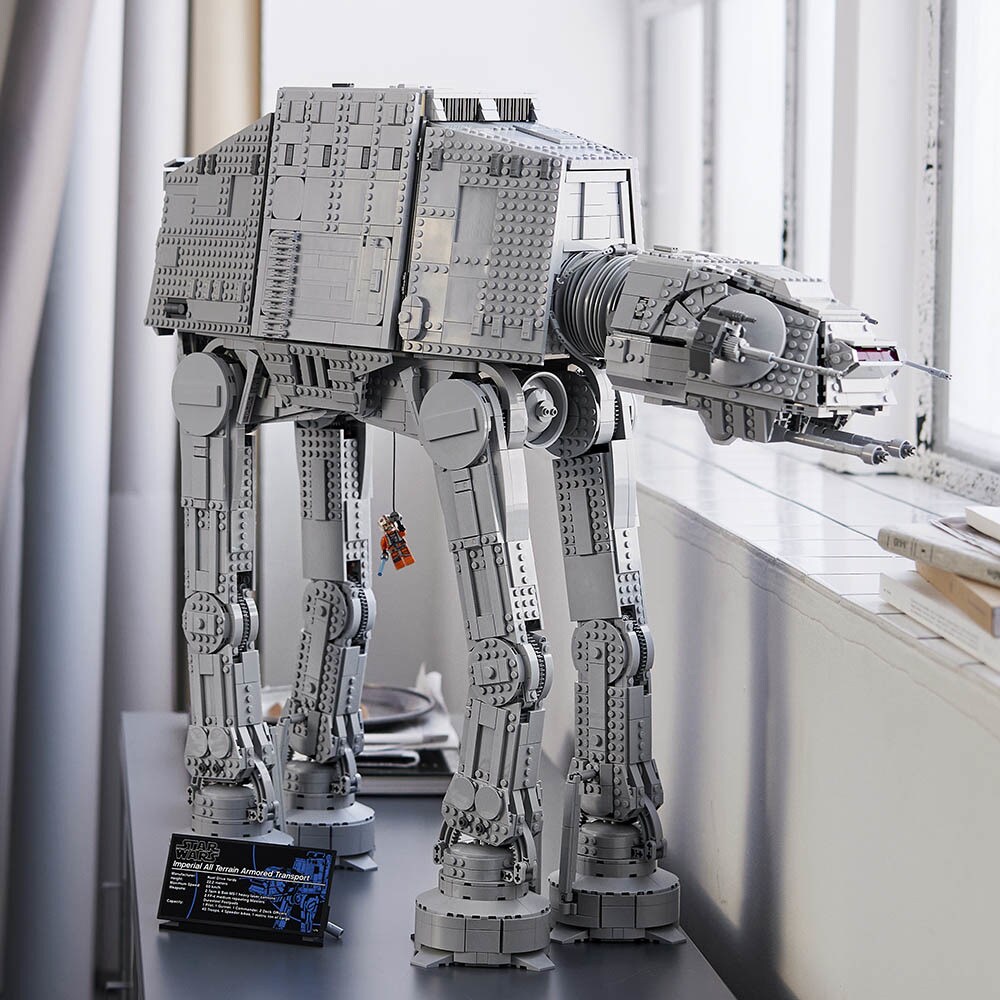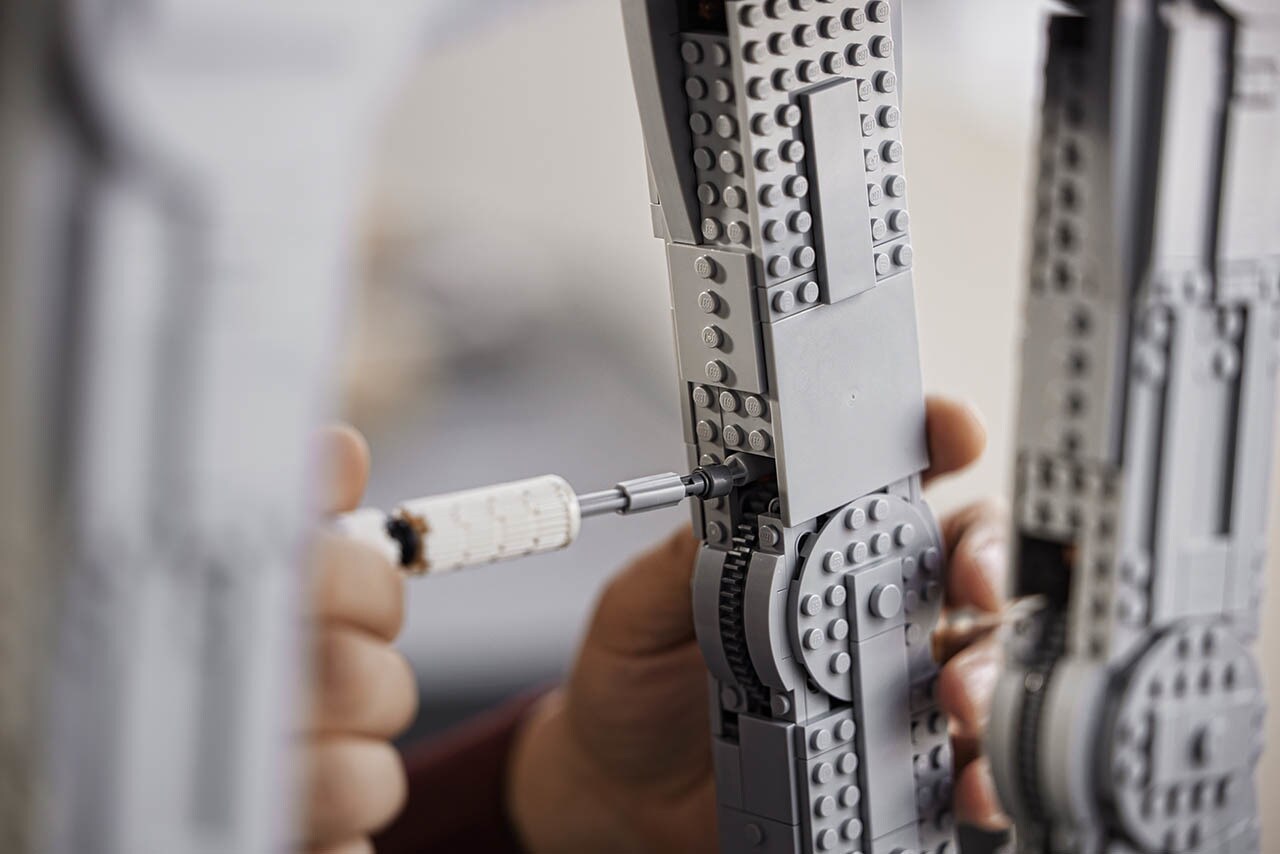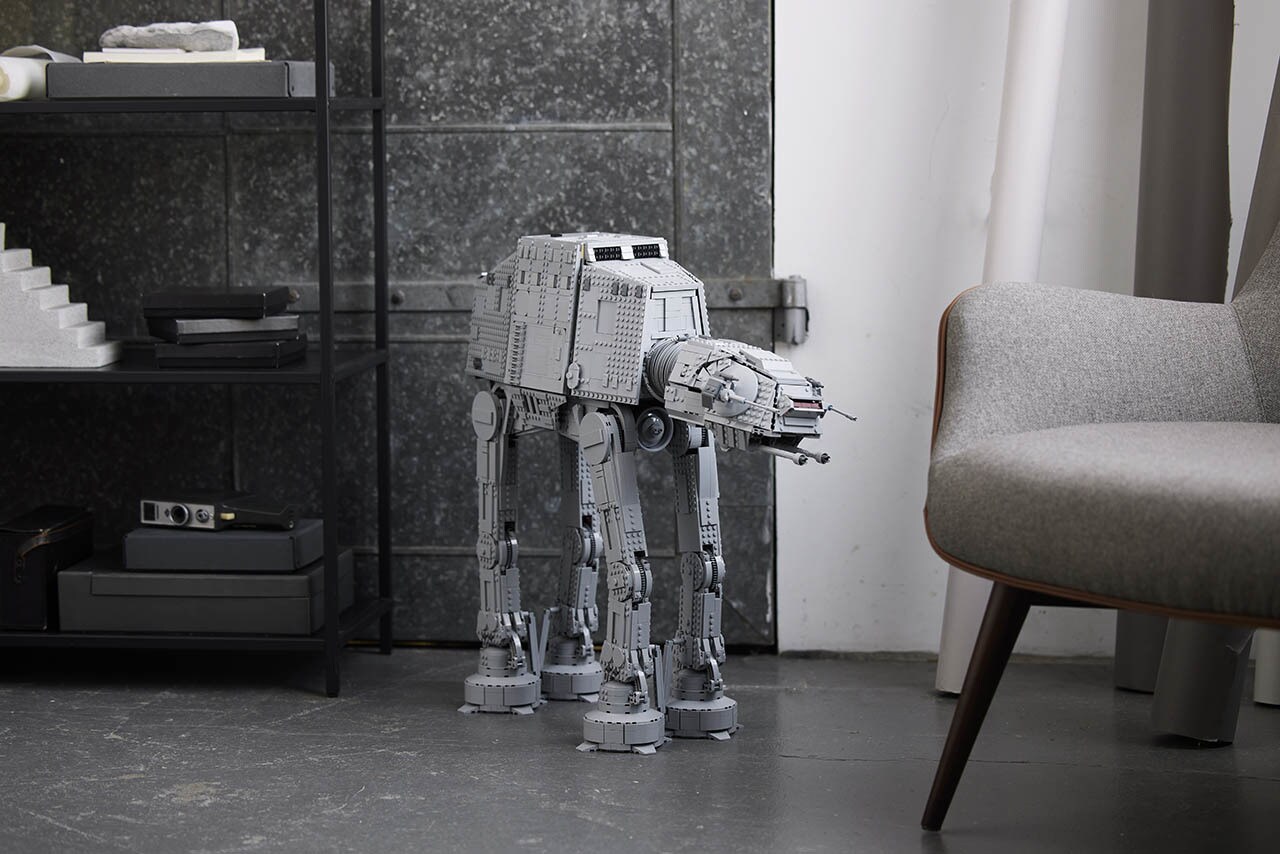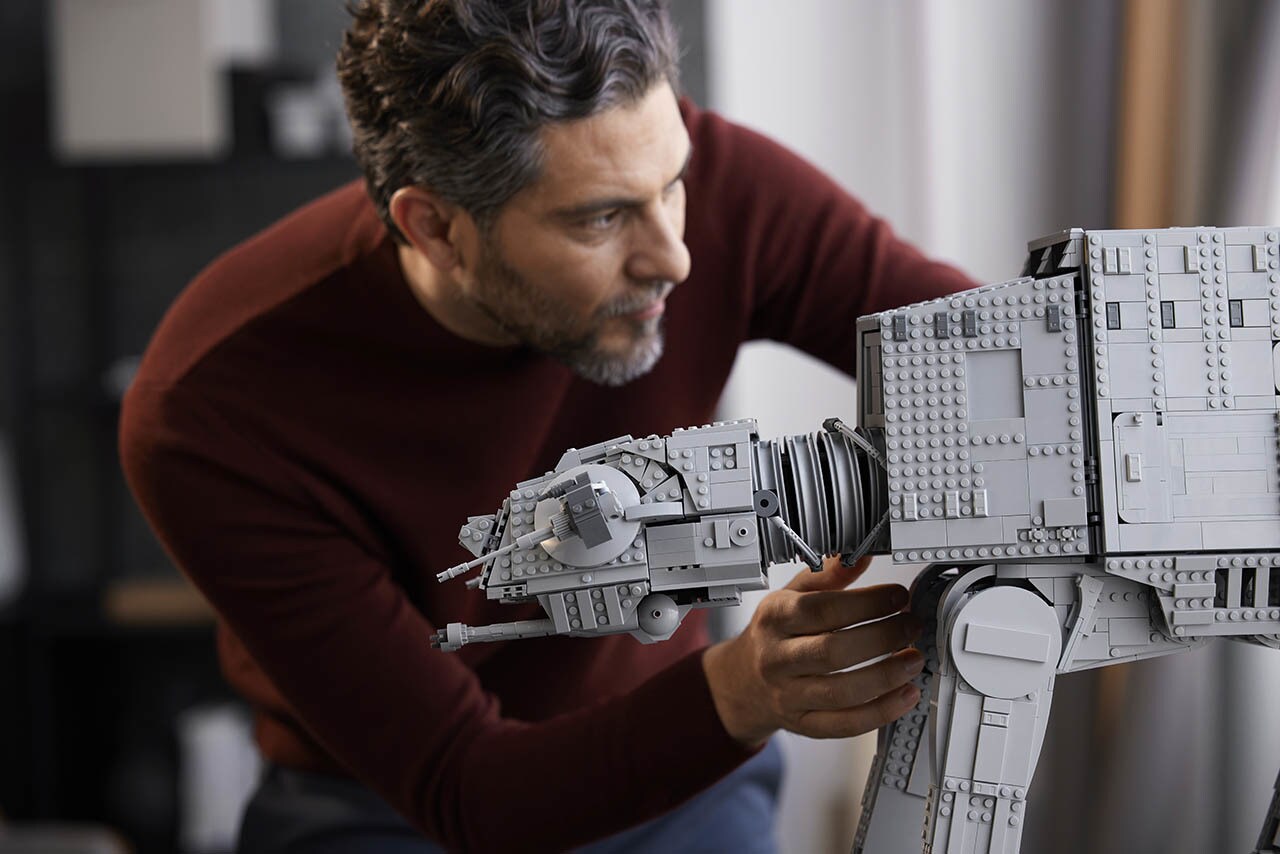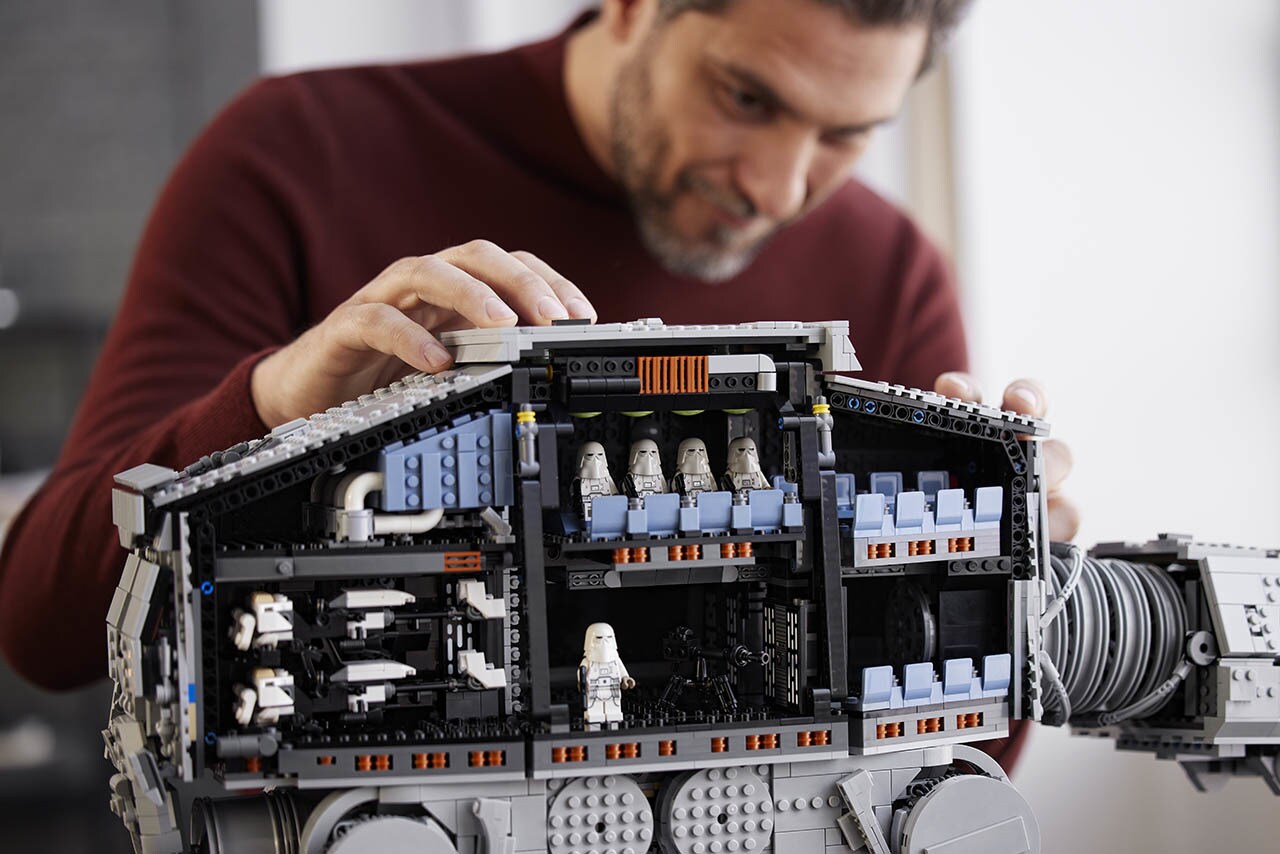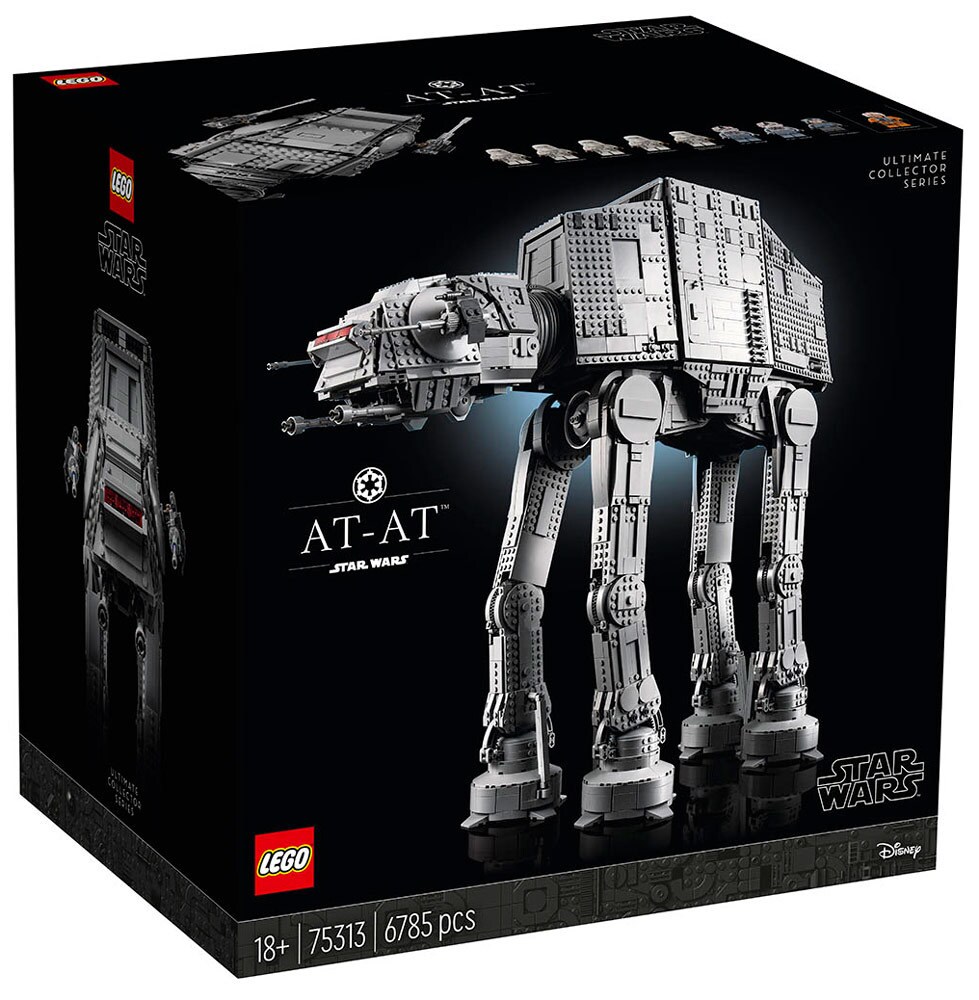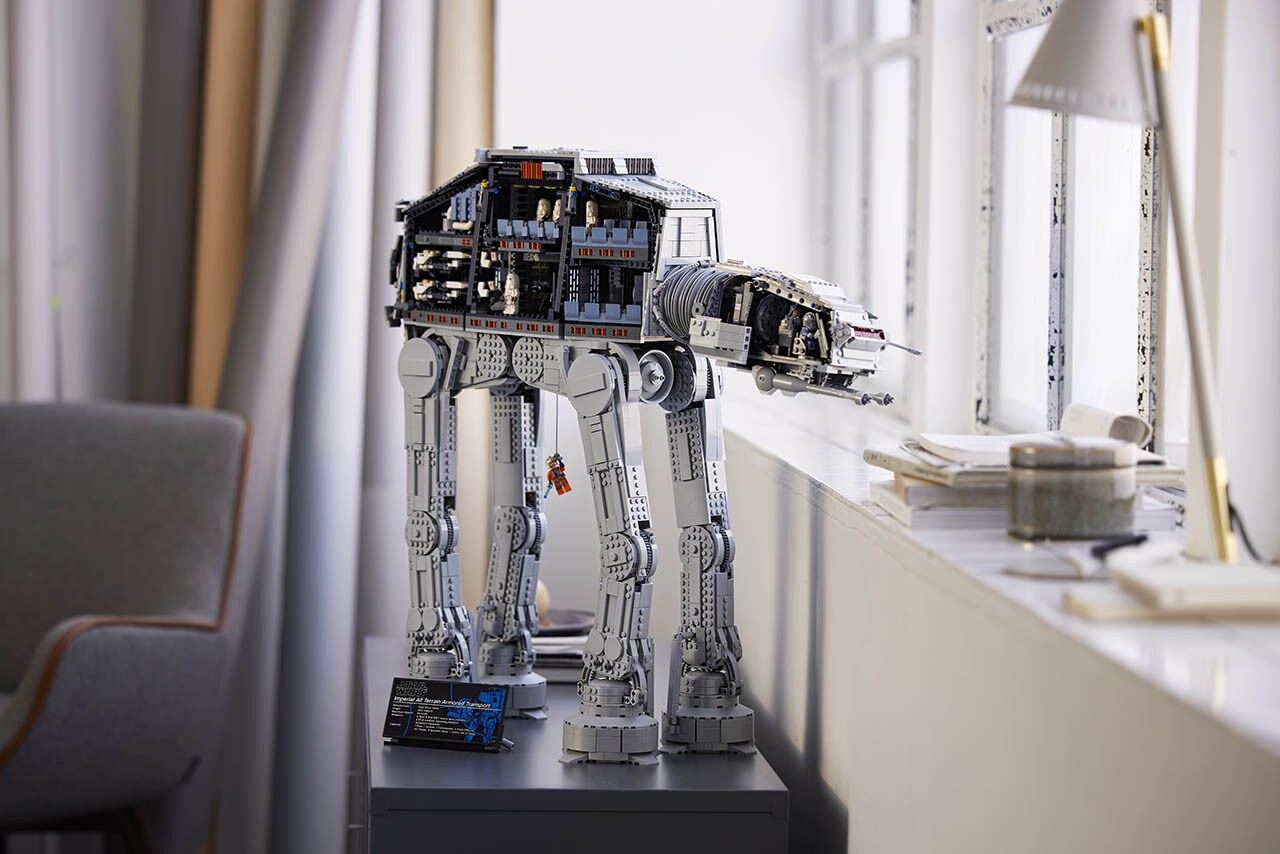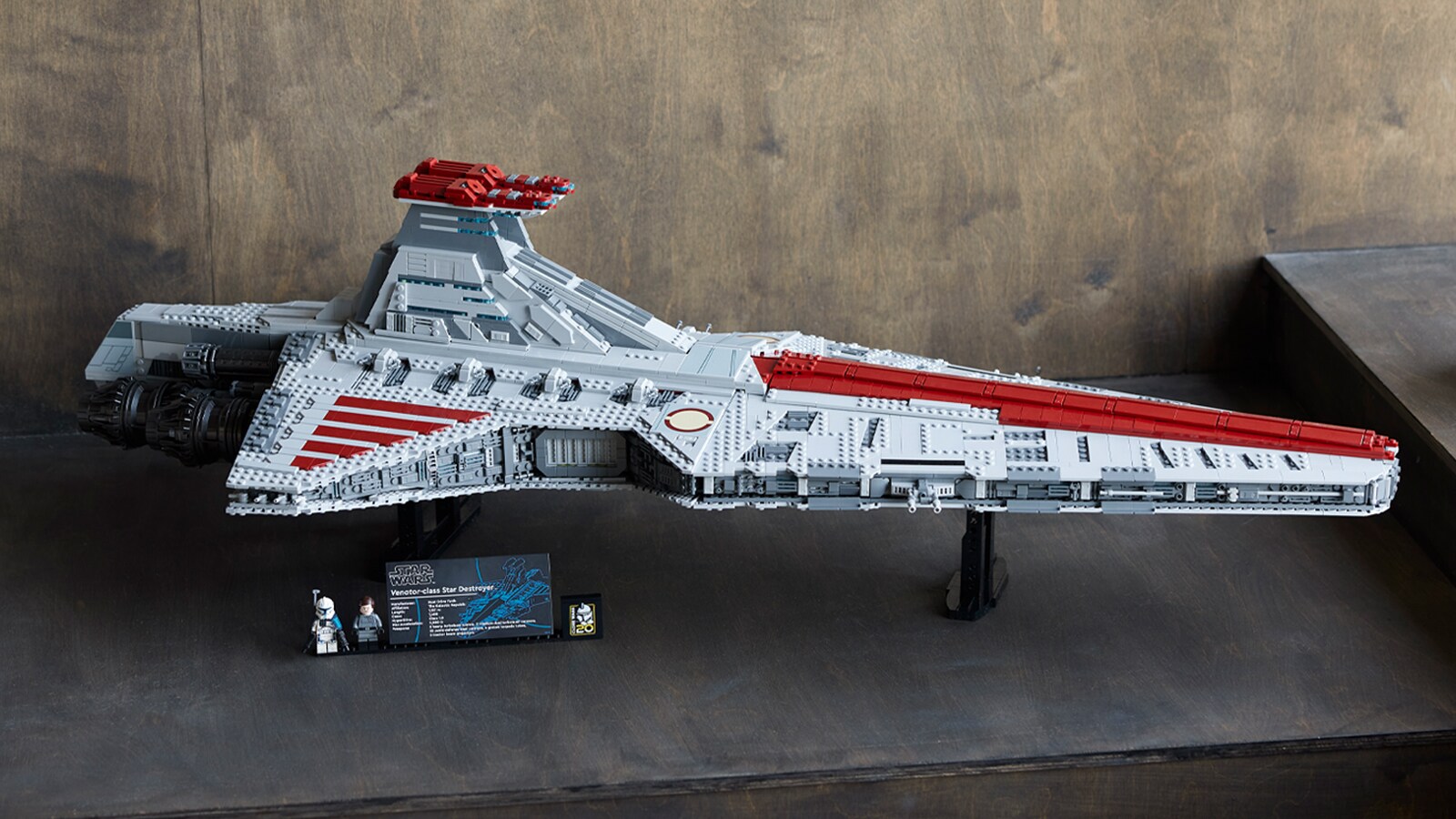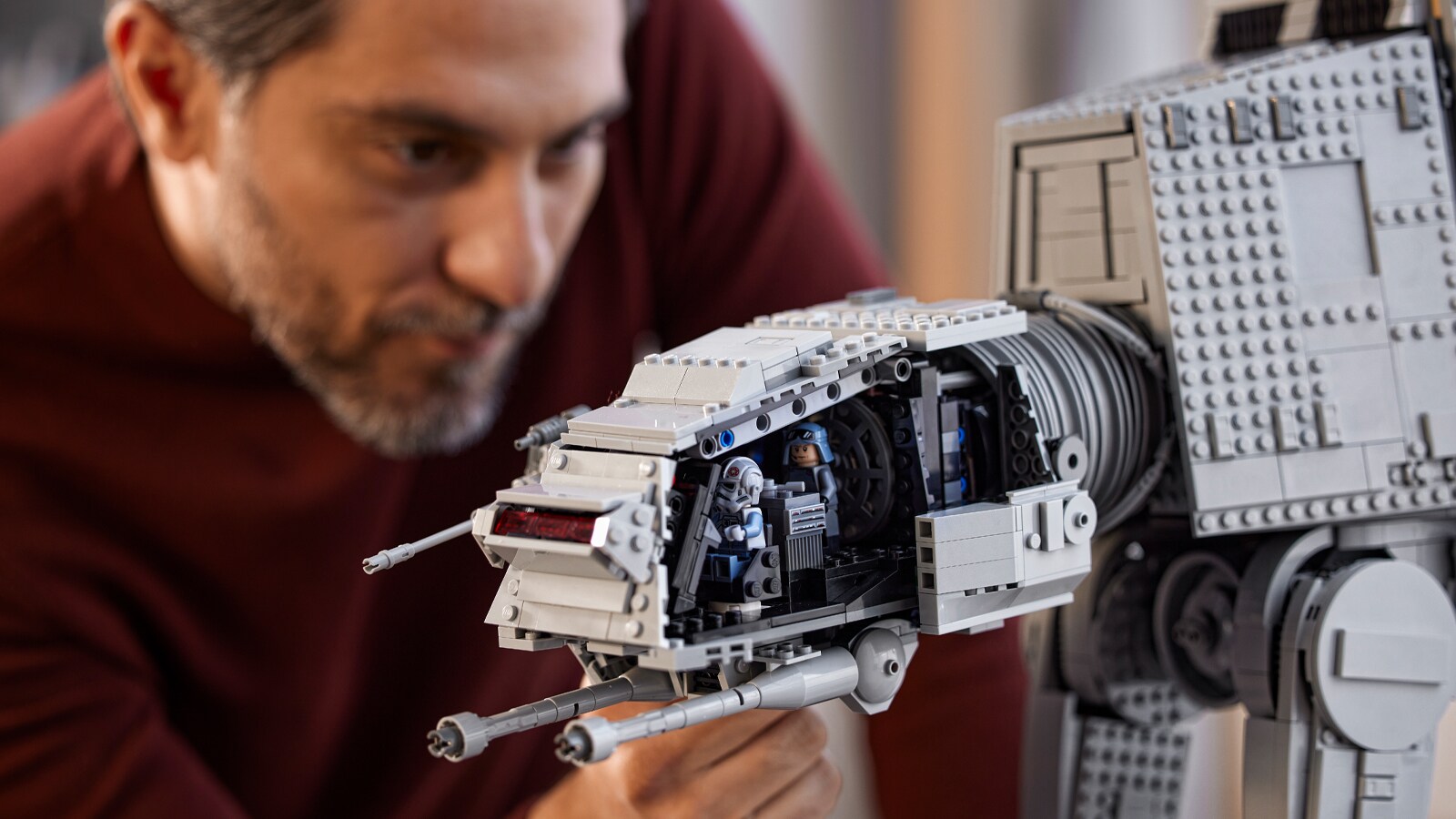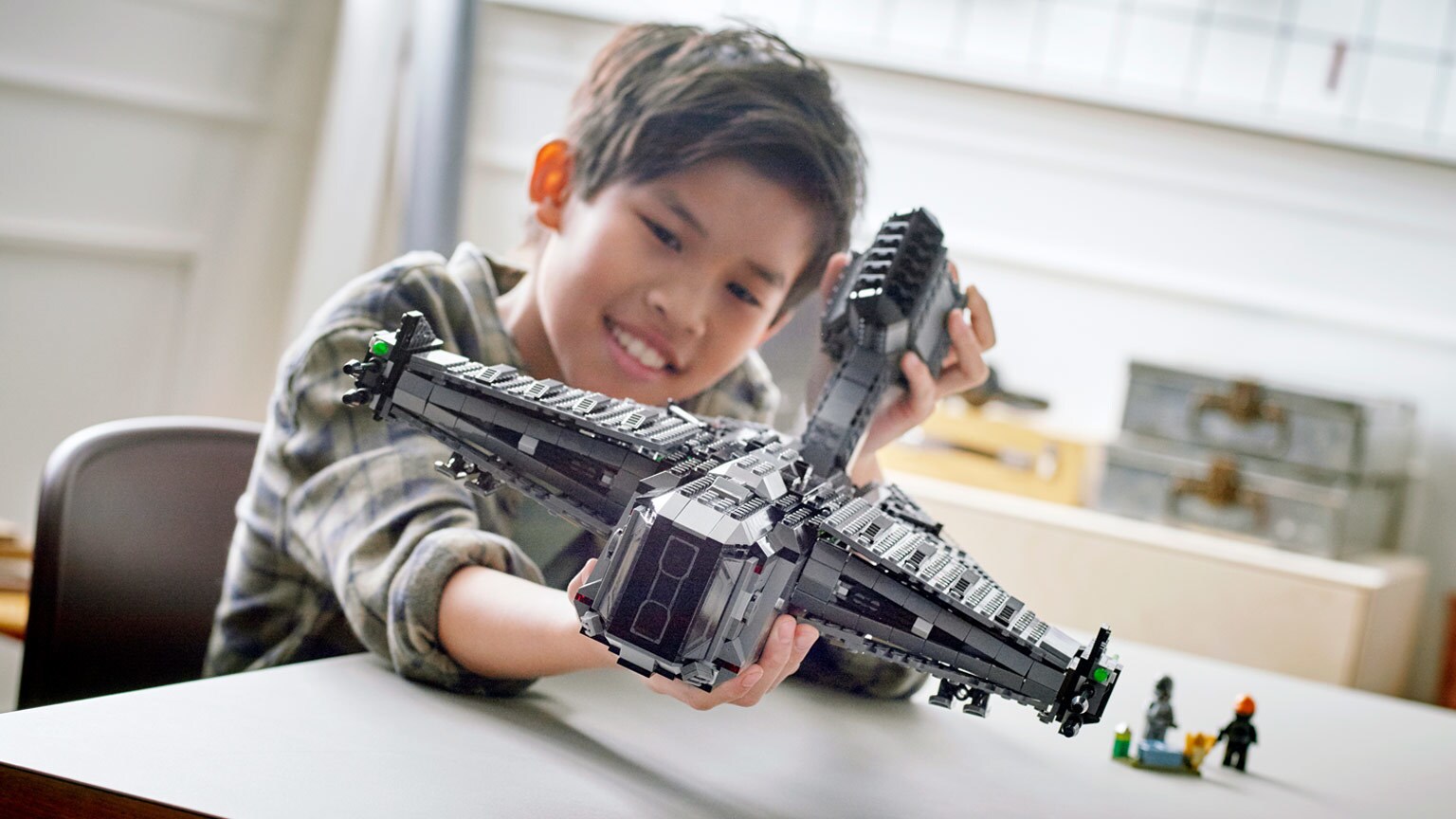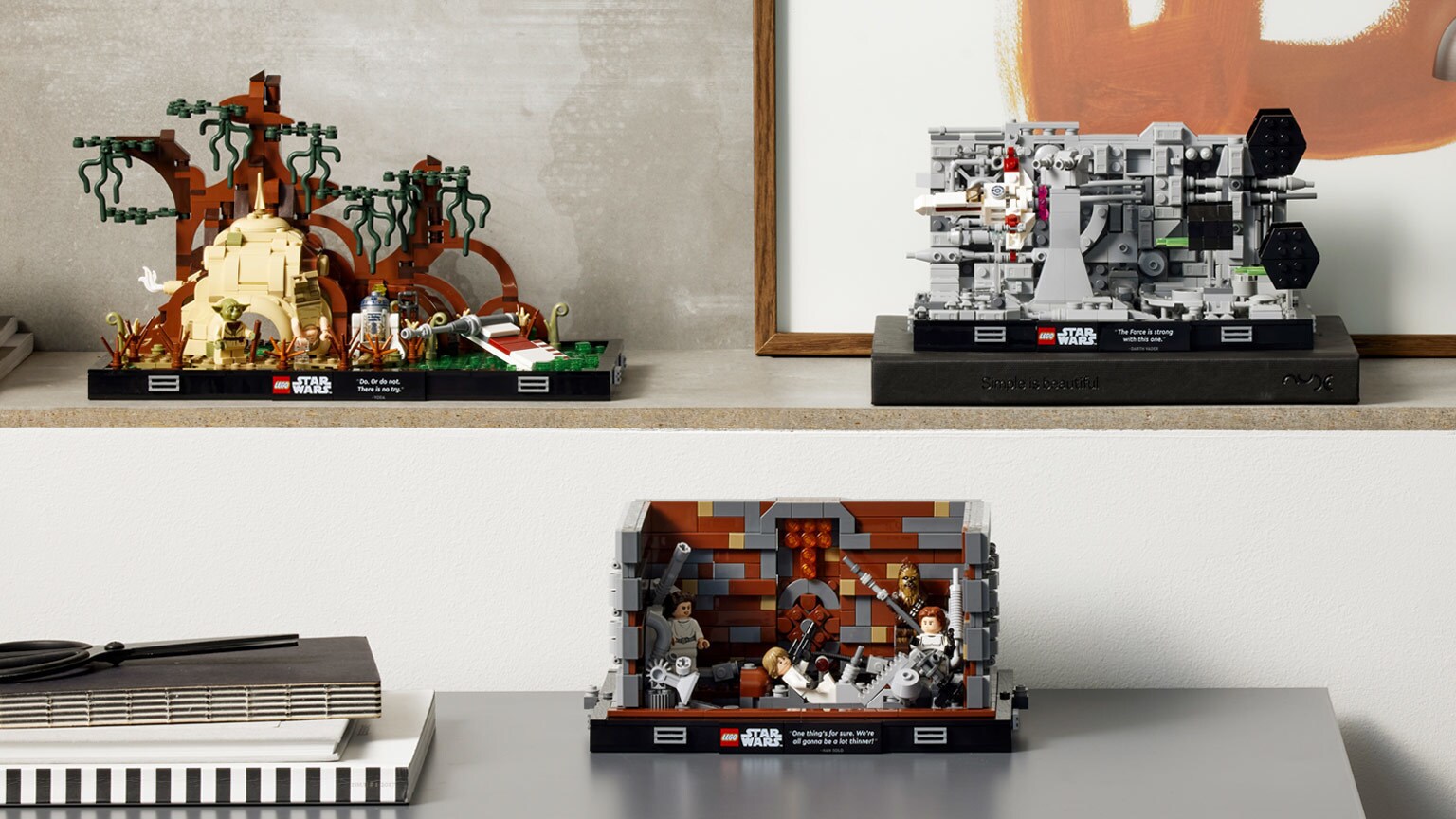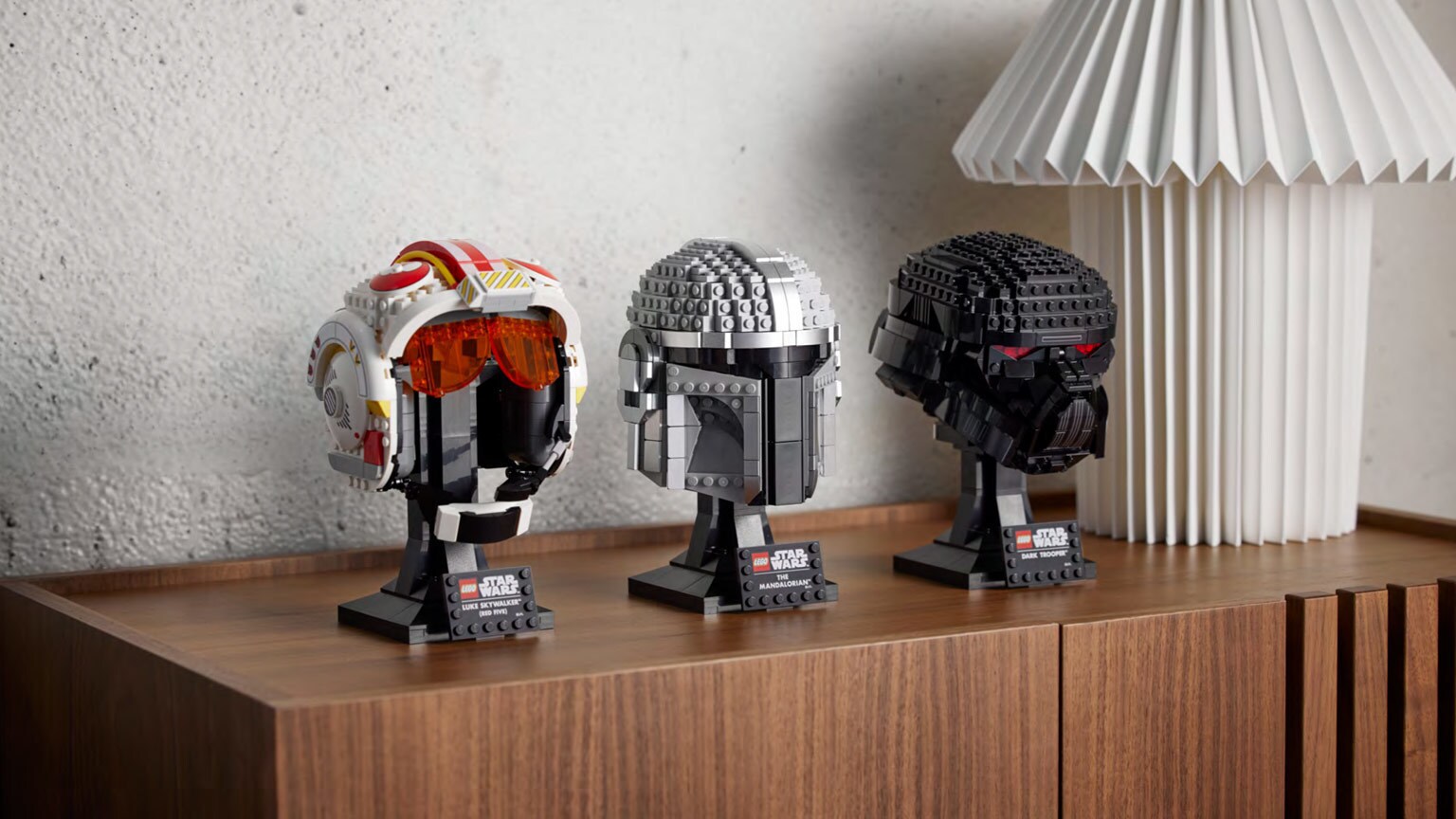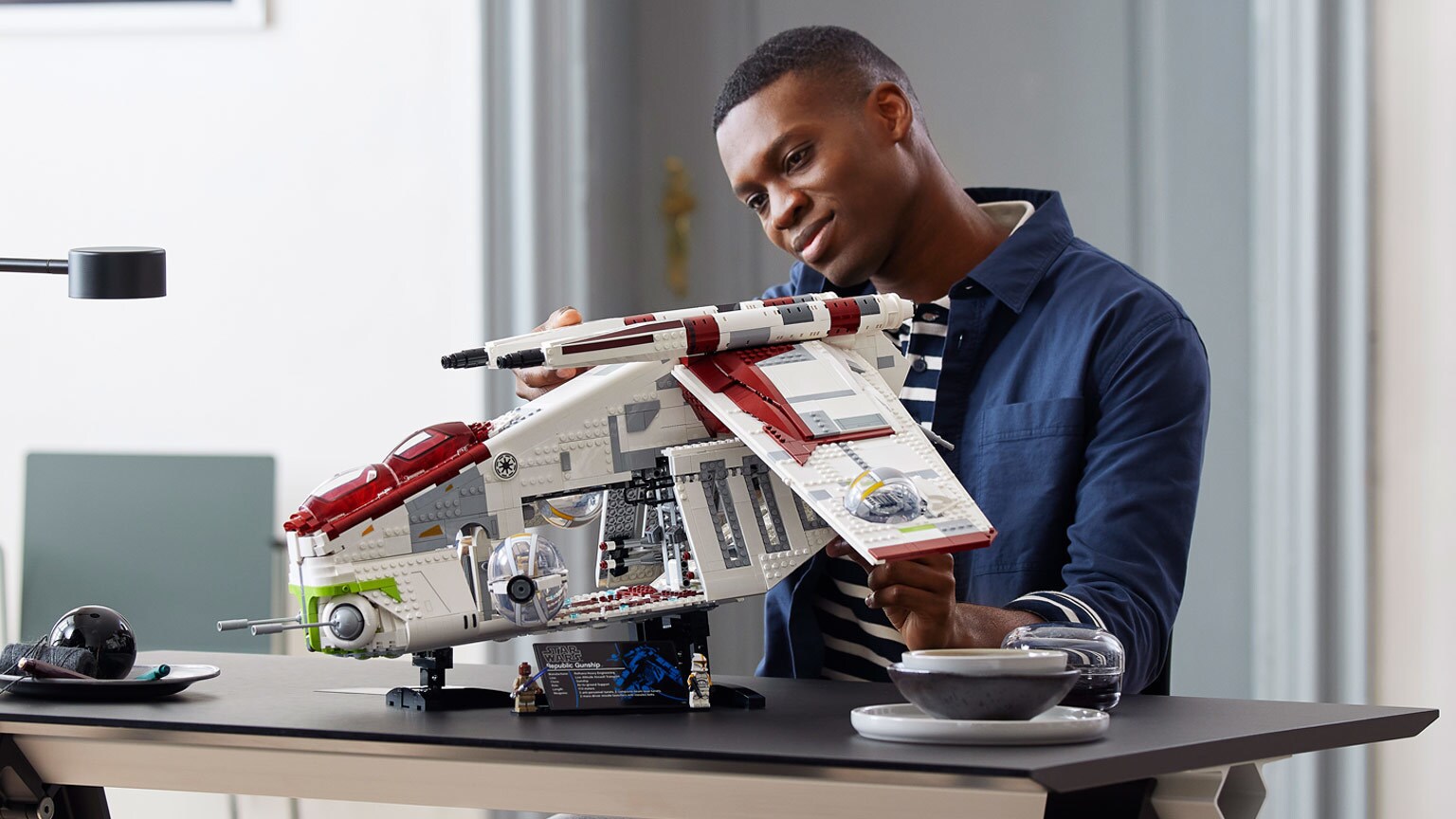Inside my office you’ll find an Imperial probe droid, Rey’s speeder, and Anakin Skywalker’s podracer. And they’re all made out of LEGO bricks. See, I’m an AFOL -- short for Adult Fan of LEGO, in community speak. But this is a relatively new development.
In recent years, the LEGO Group has been releasing more and more sets for older fans. From the staggering Ultimate Collector Series (UCS) to new forms like LEGO Art, the legendary toy maker has created products designed specifically for those who once loved the iconic LEGO brick -- or might want to give building a try. (I was a bit of both.) For a toy commonly associated with being just for kids, it’s a surprising strategy that has met with real success, particularly through Star Wars. And it shows no signs of slowing down, especially with the reveal of the new LEGO Star Wars UCS AT-AT: a downright huge model of the iconic vehicle, designed for display, and coming November 26. The set clocks in at an astonishing 6,785 pieces -- measuring 24.5 x 27 x 9.5 inches -- and features a movable head, spinning guns, adjustable legs, and side panels that can be opened and closed; on the inside, fans will find a cargo bay, seating for Snowtroopers, and classic Imperial design elements, like vertical lights. The UCS AT-AT also comes with nine minifigures and accessories, including Luke Skywalker (complete with grappling wire to scale up the walker and slice at its underbelly), General Veers, four Snowtroopers, a Snowtrooper Commander, and two AT-AT Drivers, along with two speeder bikes and an E-web cannon. So prepare to target the main generator…and make some space on your LEGO shelf.
StarWars.com recently spoke at length with Mike Ilacqua (global head of product, LEGO Star Wars, at the LEGO Group), Jens Kronvold Frederiksen (creative lead of LEGO Star Wars at the LEGO Group), and Chris Gollaher (director of product design at Lucasfilm) about developing products geared toward AFOLs, what differentiates sets made for kids and adults, and how they dreamed up the UCS AT-AT.
Star Wars.com: When did the LEGO Group start to take notice that adults were a growing part of its audience?
Mike Ilacqua: First and foremost, adults have been an important part of our fanbase for a long time, but it’s really been in the last few years where we’ve definitely seen an opportunity with adults who are hyperconnected and overstimulated with screens. LEGO building just provides them an amazing outlet to be able to disconnect, recharge, regain their balance. You can really achieve that flow with LEGO building.
One thing that has really provided a bit of that emotional hook has been passion points. There’s been a concerted effort the last few years to actually design products that are centered around passion points. Of course, Star Wars is a huge passion point with adults and we’ve had a really strong AFOL audience for some time.
It’s really opened up the opportunity to broaden that to a wider base. That’s where LEGO building for adults has really caught on these last few years, and accelerated by what we’ve experienced the last 18 months. Those factors have been dialed up -- the overstimulation, but also more time at home and more need to find ways to disconnect and enjoy yourself centered in your passion. It’s been a perfect storm that’s led to the growth we’ve seen the last few years.
Chris Gollaher: Building on that (no pun intended), I think to Mike’s point, we’ve known that there are adult fans who love the LEGO brand. It’s always been a part of the line, with products like the Ultimate Collector Series [UCS], which were more differentiated by complexity of the set. The builds were a little more difficult, more pieces, and so on.
And to Mike’s point, what has really changed in the last few years is that shift of focus of why people are building with LEGO. A lot of them were coming in because, as the passion point brings up, they were Star Wars fans or LEGO fans, but now we’re kind of expanding it where people are looking for an experience that the LEGO sets can bring in a very unique way.
Jens Kronvold Frederiksen: We’ve been working with LEGO Star Wars since the beginning, Chris and I, and we acknowledged right away that there was a huge [adult audience]. We just saw it in the office when we started with LEGO Star Wars -- how many of my colleagues were super interested and into that.
It was already, in the year 2000, the second year of LEGO Star Wars, that we introduced the Ultimate Collector Series models. At that time, I think they were marked 16+, but we knew that these were something that were definitely more complex and targeted to an older audience. And because of that we had a special packaging. Do you remember, Chris? It was black and white.
Chris Gollaher: Yeah!
Jens Kronvold Frederiksen: It was made to look a little more elevated and cooler. Lately here, when we released the helmets, we also got to another audience. The UCS models have been typically big sets. The helmets are maybe a little bit easier to get a hold of.
Chris Gollaher: That’s a great point, too. When I say we’re expanding, one of the things that has been a more recent addition, with things like helmets and some of the upcoming projects, is the Ultimate Collector Series were very much something aspirational. They were big sets. They were complex. They were for an advanced and pretty core LEGO builder.
With the expansion of the adult LEGO program, we’re bringing in different levels of experience and engagement. It’s still a complex build, it’s still designed for older fans, but it allows you to get in at different points, which I think has been really well-received by our fans, both Star Wars and LEGO fans.
StarWars.com: I became a LEGO fan in my 30s during the early 2010s, and it was through sets that were targeted to adults. There were things like the DeLorean from Back to the Future, the ECTO-1, and the bigger Star Wars sets. When was there a clear shift toward “We are making sets for AFOLs or for people who could become AFOLs” from “We’re making LEGO Star Wars sets for kids, but adults are buying them, as well?” These were products that were clearly made for people my age and my cultural touchpoints.
Mike Ilacqua: It was an intentional approach to broaden our reach among adult audiences. I’ll go back to the insight that we identified, that LEGO building can fulfill a need that adults are looking for -- to showcase a passion that they’re super engaged with in a different way, and that there’s a broad set of passions for adults that they want to tap into.
There was a perception that we needed to overcome, and I think you hit on it, that “LEGO building is just for kids,” when in fact it has so much appeal when you’ve actually had the experience. The biggest challenge we had was removing or overcoming that barrier that LEGO building is just for kids. That has taken a real thoughtful approach around, “How do you design sets that are more accessible?” to Chris’s point. You’d have to be a real AFOL and a real passionate LEGO builder to go after a 7,000-piece set. How can we bring some models to life that are more accessible?
The other is how those products are not just marketed, but also packaged. Jens mentioned it. One thing we really tried to do is design for this audience first and foremost. That was everything from product to the packaging. When you go to a retail store or online, you’ll find some premium packaging that is unified across the LEGO line. It clearly speaks to an adult audience. Those key touchpoints and elements that needed to be unified across the LEGO portfolio to lift broader awareness around the products and the different passion points that are now accessible in LEGO models.
Jens Kronvold Frederiksen: It’s also a different kind of product. I just remember it had always been, when we created LEGO models, it was about giving a great play experience. But here, it’s a display experience, you can say. [Laughs] It’s about having a great building experience, of course, then the products are purely made -- for instance, the helmets -- for display. That’s really different from our standard products, of course.
Chris Gollaher: I think that’s a great point. I think Jens and his team have done a fantastic job in how they approach the design and features between sets that are geared for younger audiences -- [Laughs] they’re for everybody, let’s face it. I have as much fun building the 7+ sets as the 18+. But the kid-directed sets tend to be more mini-figure driven. They have features, they have play -- once you build them, you can play with them.
The adult-targeted set tends to have less of those features built in, and more of the display details. The amount of small detail that goes into it really comes out in those adult sets, I think, in a fantastic way. That’s where the focus is. That’s where the number of bricks, the way we use it, the way we do the build is really designed to be as accurate as possible to that vehicle or that helmet or that moment. Whereas in the kid [set], it’s play first. Obviously, we still want to be accurate. Jens and his team do a fantastic job -- interpreting the physical thing into a brick form. But there are play factors built in there.
So when you put an Ultimate Collector Series X-Wing next to our core line X-Wing, they both are clearly X-Wings and look fantastic, but the amount of detail and the functionality are a little different between the two.
StarWars.com: Jens, can you talk about, from your perspective, what it was like when you did have to take those first steps into switching from something that was more toy-based in terms of LEGO design, versus something that was going to be a collector’s piece?
Jens Kronvold Frederiksen: It was an interesting process. We had some experience with the Ultimate Collector Series models, but it was still [early].
Now, talking about the helmets, it was an interesting thing because we tested prototypes with consumers. One thing that was really interesting was, we had -- I’m becoming a little bit nerdy here going into detail… [Laughs]
StarWars.com: That’s okay!
Jens Kronvold Frederiksen: We had these flat-shaped elements that had a nice, flat surface. So we tried to build a helmet. I remember we had a Boba Fett helmet at that time, that was built looking really authentic with these shape elements [mimes a curved shape]. The feedback we heard was that people really wanted to look like LEGO sets and thought, “Hey, where are the LEGO knobs?”
And then we tried to create it from more standard LEGO elements with more visible knobs, and that was exactly what people wanted. They want, when it’s displayed, it should be visible that this is something that consists of a lot of pieces. In other words, that it’s actually a challenge to build it. But also it should clearly distance from any other display piece by showing that it’s the LEGO brand. So there were a lot of learnings.
Then one of the things I really love is, when briefing the designers, usually it’s important passing on, “Hey, remember this is a 7+ product,” meaning when you design and construct the model, keep in mind that it should be a great building experience for a seven-year-old with the limitations it gives. But here, you can just go crazy. Just build whatever! Because that layer of complexities is actually a great thing. People want these models to be complex and not just done within half an hour or so.
StarWars.com: I have the new R2 that’s about a foot tall, and my six-year-old quickly took over the build from me. [Laughs] It says 18+ on the box. I quickly became his assistant.
Mike Ilacqua: What’s really cool about that example, and we see this all the time, is that it can move the parent or the older sibling out of the role of assistant and into the role of building for themselves. You can be sitting at the table building your Boba Fett helmet while your child is building Boba Fett’s Starship. Those are very different expressions, but an experience you can share together because you have the unifying factor of the character and the Star Wars IP, as well. It just makes a really fun complement for the family.
StarWars.com: On that note, speaking from a parent’s perspective, building together was one thing I did not anticipate. I got into LEGO building, a couple of years after that my kids were born. They got into LEGO building. But part of the appeal of it to me now is that it’s something we can all appreciate and do together.
Chris Gollaher: That’s one of the things that makes this such a fantastic relationship between the LEGO Group and Star Wars. Both of them have that cross-generational appeal. The parents and the kids share it in the storytelling of Star Wars, and then the experience of the LEGO brand. And that’s why it’s so great. It works so well and hits on all levels for that.
Jens Kronvold Frederiksen: It’s something we’re aware of. And specifically, if you look at a product like our Mos Eisley cantina -- this huge set that’s actually 18+ because it’s a pretty big build -- that model has play features and functions. And a lot of minifigures. It’s this crossover thing [that] really gets the whole family building it together and has hours and hours of role-play in it. You have role-play or display, so that’s a little bit in-between, you could say.
StarWars.com: After I got into LEGO building, I was really surprised once I started to explore everything around it. I love that you welcome fan designs and will even put them into production with LEGO Ideas. The community is very welcoming, the VIP program is really well put-together. The overall tone is very positive. As an adult fan, both on my own and as a parent, that was very appealing. I’m curious how you developed this and fostered it.
Mike Ilacqua: It’s not by accident. We have colleagues who are dedicated to engaging with our fan community. That’s one thing in particular that we take and hold in a very high regard. We wouldn’t be anywhere without our fans and we continue to listen to them and, obviously, address all the play needs that they’re looking for. It’s a real thoughtful approach.
Again, thinking about how do you build community around the LEGO brand? It’s one where creativity is paramount, we are able to see and be inspired by our fans all over the world, by their own creations. They build models and create amazing LEGO photography [and] their own user-created content. There is just such an amazing and creative fan community out there and we love being able to elevate their work and their voices. To be able to do that, we have to stay very connected to them. So we have a dedicated team that’s fully focused on engaging with the fan community.
And then we’re able to use our platforms to really give them the exposure that they deserve, which is super fulfilling when you get to see products land in their hands, and then they have their own creative expression to it.
Jens Kronvold Frederiksen: I will also say, from our point of view in the design team, it’s something that’s really, really important. We are following these [fans] and always, when we’re launching new products, we’re super excited to hear what they think of it and so on. We are also using the feedback.
For instance, when we’re going to relaunch or make a version of a product that we’ve done before, we’re always looking into, “What were the reviews last time? What can we improve?” And so on. And the same thing for brand-new things. We have a pretty good idea of what they wish for, and we of course always try to fulfill those wishes when launching new products. It’s really important for us.
StarWars.com: I think the LEGO brand is doing an amazing job with it. One thing that impresses me about LEGO’s strategy for AFOLs is that it seems like the product goes beyond just a nostalgic play. Meaning, you’re not just re-releasing sets that people grew up with. To use LEGO Star Wars as an example, you have the helmet series, you have the art series, and items that are more display pieces, like the new Ultimate Collector Series AT-AT. Can you talk about how this approach evolved?
Mike Ilacqua: I think Chris hit on it a little bit earlier. It does come down to thinking about the various audiences out there and how do you design the portfolio in a way that brings more people in to LEGO building. I think what we recognized is there was an entry point that we can create, that made building that much more accessible to some of those adult fans who maybe have gone many years without a LEGO building experience. If we could drive awareness of these new models that have that nostalgic emotional hook to them that obviously brings them in, if we can pay that off with a really awesome model that’s highly detailed but it’s accessible and something that they could feel confident that they could build, then that was a way to start building a broader tent of LEGO builders.
We still want to make sure that we are addressing and delighting those adult fans of the LEGO brand who are looking for the bigger challenge time and time again. They’re the ones who, if you have the Venn diagram, Star Wars isn’t their only passion. Actually, LEGO building is their passion, too. So you want to make sure that you’re also surprising and delighting them with even more detailed sets, complicated building, more functionality, and just ensuring that we continue to surprise and delight them with every big launch.
StarWars.com: Have you found that any of the new kinds of products are gateways into more traditional LEGO building? Like the art portraits, for example? I could see getting that for my dad, and then that opening a door to, “Oh, I want to build this TIE Fighter.”
Mike Ilacqua: We do see that these are on-ramps. That’s another reason why we’ve really created a broad and diverse array, it opens your eyes to other ways you can express your fandom. Whether it’s coming in through art and design, or it’s coming in through your passion around vehicles, those are different on-ramps but it will bring you to a much larger world of LEGO building that’s out there.
Chris Gollaher: I think that’s a great point and I’m glad you brought up the art sets, because those are fantastic. They really showed that, yes, a LEGO set is a great toy, and we’ve known that and it’s fantastic, but it’s also as much an experience as it is the product itself.
When you have something like the art series that you can engage [with] and spend that time, and it was very thoughtfully designed to be an experience for the builder and to have a moment of zen, if you will, as they’re putting this together. It shows people that it’s a great product, a great toy, but also a great experience. I think that’s what some of these older-targeted sets can do as well.
StarWars.com: For LEGO Star Wars, which is obviously huge with kids -- and that is a really important audience for both Lucasfilm and the LEGO Group -- how have you worked to balance that audience with the AFOL audience in terms of making sure you’re catering to both in the appropriate way?
Mike Ilacqua: Kids remain at our core. There’s no doubt about that. You definitely see that translate into the amount of products that we design towards a kids audience versus a more up in age, adult audience. It’s a lot harder to become an AFOL if you didn’t have an experience LEGO building as a kid. To continue building that pipeline of future builders is super important. The LEGO Group first and foremost is really focused on bringing more and more kids every year into LEGO building, keeping their minds creative and imaginative.
Our LEGO Star Wars franchise plays an important role because it has such a wide reach and a fandom out there that we can tap into and continue to foster for years to come.
StarWars.com: Chris, from the Lucasfilm side, how do you feel about appealing to both those audiences?
Chris Gollaher: I think, as Mike said, kids remain at the core, and that’s throughout the year. But we work closely together, the Lucasfilm team and the LEGO team, to look at that release calendar over the year and make sure we’re pulling the right levers, if you will, on timing and content. Which are really kid directed, and which are the times and moments where we can do something that’s going to appeal to older fans, as well. May the 4th is obviously a good example where we sometimes lean more into that older fan, because it’s such an ingrained part of that Star Wars fan experience.
So we work closely together throughout the year to make sure we’ve got that balance, that we’re keeping our baseline business strong and healthy but making sure we’re dropping in those additional moments for our older fans, as well.




